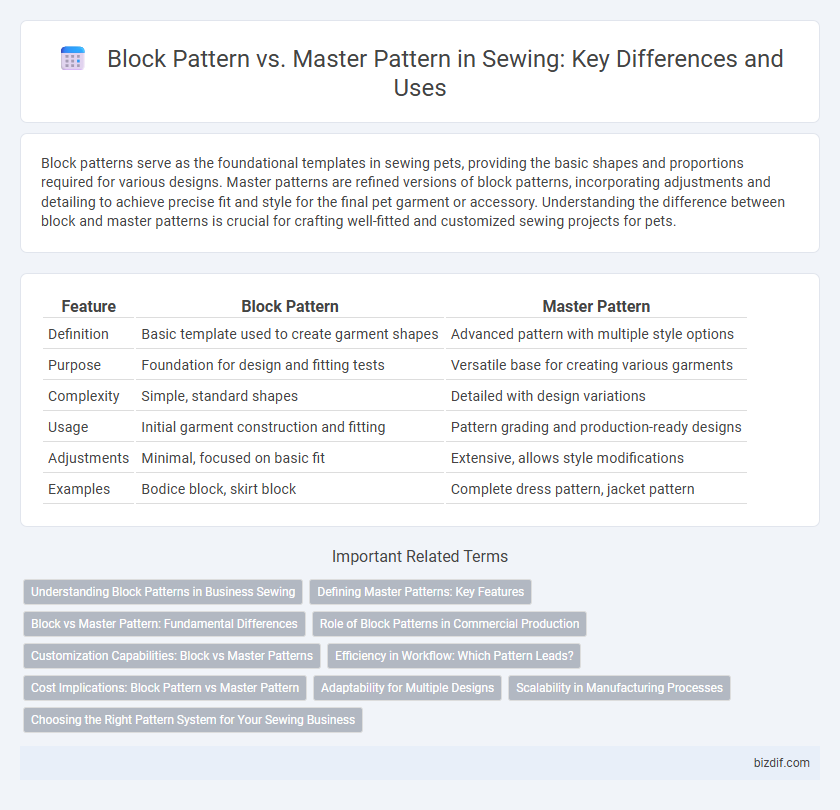Block patterns serve as the foundational templates in sewing pets, providing the basic shapes and proportions required for various designs. Master patterns are refined versions of block patterns, incorporating adjustments and detailing to achieve precise fit and style for the final pet garment or accessory. Understanding the difference between block and master patterns is crucial for crafting well-fitted and customized sewing projects for pets.
Table of Comparison
| Feature | Block Pattern | Master Pattern |
|---|---|---|
| Definition | Basic template used to create garment shapes | Advanced pattern with multiple style options |
| Purpose | Foundation for design and fitting tests | Versatile base for creating various garments |
| Complexity | Simple, standard shapes | Detailed with design variations |
| Usage | Initial garment construction and fitting | Pattern grading and production-ready designs |
| Adjustments | Minimal, focused on basic fit | Extensive, allows style modifications |
| Examples | Bodice block, skirt block | Complete dress pattern, jacket pattern |
Understanding Block Patterns in Business Sewing
Block patterns serve as foundational templates in business sewing, offering standardized shapes that streamline garment production and ensure consistency across different styles. Master patterns, derived from these blocks, incorporate specific design details and adjustments to meet fashion trends or client specifications. Efficient use of block patterns reduces development time and fabric waste, enhancing overall production workflow and cost-effectiveness.
Defining Master Patterns: Key Features
A master pattern serves as the primary, fully finished template from which all sample and production patterns are derived, ensuring consistency across garment pieces. It includes precise notches, grainlines, seam allowances, and detailed markings crucial for accurate construction and fit. Unlike block patterns, which are basic and unadorned templates used primarily for drafting, master patterns incorporate all technical specifications and are ready for grading and production.
Block vs Master Pattern: Fundamental Differences
A block pattern is the foundational template created based on basic body measurements, serving as the starting point for designing various garment styles. In contrast, a master pattern is a refined version of the block that incorporates specific design details, seam allowances, and style elements tailored for final garment construction. Understanding the fundamental differences between block and master patterns is crucial for efficient pattern development and accurate fit in sewing projects.
Role of Block Patterns in Commercial Production
Block patterns serve as foundational templates in commercial sewing production, streamlining the creation of consistent garment fits across various sizes and styles. They enable efficient grading processes, reducing errors and time spent on adjustments while ensuring pattern accuracy. This foundational role accelerates design development and supports mass production scalability.
Customization Capabilities: Block vs Master Patterns
Block patterns serve as foundational templates with basic shapes, enabling easy modifications for customized garment designs. Master patterns incorporate detailed garment features and intricate design elements, offering greater precision for advanced customization and fit adjustments. Customization capabilities in master patterns surpass block patterns by providing a more accurate base for complex tailoring and style variations.
Efficiency in Workflow: Which Pattern Leads?
Using a master pattern streamlines sewing efficiency by allowing consistent reproduction of garment pieces, reducing time spent on repeated adjustments. Block patterns serve as foundational templates but often require modifications for each design, potentially slowing workflow. Therefore, master patterns lead in optimizing production speed and workflow consistency in sewing projects.
Cost Implications: Block Pattern vs Master Pattern
Block patterns reduce initial design costs by providing a reusable template for multiple garment variations, streamlining production and minimizing fabric waste. Master patterns, while requiring higher upfront investment due to their complexity and detail, enable precise fit and customization that can lower alteration expenses and increase garment quality. Choosing between block and master patterns significantly impacts overall manufacturing budget, balancing initial pattern-making costs against long-term production efficiencies.
Adaptability for Multiple Designs
Block patterns provide a versatile foundational template that can be easily modified to create multiple garment styles, enhancing workflow efficiency. Master patterns serve as a refined base with detailed shaping and fit adjustments, allowing designers to develop a cohesive collection with consistent sizing and silhouette. The adaptability of block patterns makes them ideal for initial design experimentation, while master patterns ensure precision and uniformity across varied designs.
Scalability in Manufacturing Processes
Block patterns serve as foundational templates that allow for easy adjustments and modifications, enabling scalable production across various garment styles. Master patterns are derived from block patterns, refined with specific design details to ensure consistency and precision in mass manufacturing. Utilizing block patterns streamlines the pattern development process, enhancing scalability by reducing time and costs during large-scale garment production.
Choosing the Right Pattern System for Your Sewing Business
Selecting between block patterns and master patterns significantly impacts production efficiency and garment consistency in a sewing business. Block patterns serve as foundational templates representing basic garment shapes, enabling easier customization and size grading, while master patterns integrate intricate design details tailored to final product specifications. Understanding your business scale and product complexity guides the choice, with block patterns favoring scalable customization and master patterns ensuring precision in high-detail garment production.
Block pattern vs Master pattern Infographic

 bizdif.com
bizdif.com